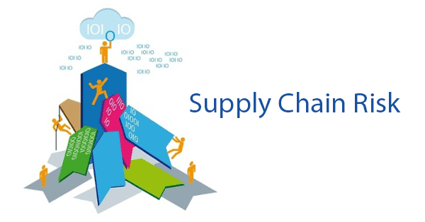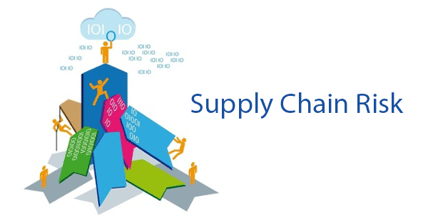A 5-step Guide to Minimizing Supply Chain Risk
Brian Hoey - June 07, 2018

 In February of 2018, popular fast food brand KFC was in the midst of making some big changes to its UK supply chain. They were in the process of switching from Bidvest Logistics to DHL as their primary distributor, while simultaneously streamlining their warehouse system from six facilities serving the country to only one. Anyone who keeps current with supply chain management likely knows what happened next: the restaurant was forced to temporarily close more than 700 of its 900 locations in Great Britain. The reason? Chicken supplies were not reaching the stores.
In February of 2018, popular fast food brand KFC was in the midst of making some big changes to its UK supply chain. They were in the process of switching from Bidvest Logistics to DHL as their primary distributor, while simultaneously streamlining their warehouse system from six facilities serving the country to only one. Anyone who keeps current with supply chain management likely knows what happened next: the restaurant was forced to temporarily close more than 700 of its 900 locations in Great Britain. The reason? Chicken supplies were not reaching the stores.
Those who have followed this story will know that even after the stores reopened, there was an issue supplying the stores with gravy, adding a dour postscript to the story that already represented one of the worse supply chain failures of the 21st century. All businesses are deeply invested in avoiding disruptions like these and taking only the most calculated of risks, but high profile snafus like this one prove that no one is immune to risk in an increasingly complex global value chain. That said, there are strategies that businesses can implement to help minimize supply chain risk.
Identify and Assess Risks
This strategy may seem a bit obvious, but in a marketplace that’s constantly growing in complexity and competition, it can often been difficult to gain an accurate picture of exactly what risks you’re opening your supply chain up to. For instance, the increased pressures to “go lean,” and to reduce inventory levels and lead times with just-in-time deliveries, combined with the new complexities introduced by the increasingly global nature of the supply chain, are leading to the creation of risks and pain points that past supply chain managers never had to consider. If, for instance, your business is becoming more and more dependent on suppliers around the globe, you may be more susceptible to disruptions based on tariff increases or local labor disputes. By the same token, as your value chain becomes more digitized, you might need to account for the possibility and potential effects of network outages on your facilities and operations.
Though this first step is perhaps the most crucial one in terms of decreasing the likelihood of breakdowns and bottlenecks, a Harvard Business Review study from a few years ago found that the majority of companies were not taking steps to asses their supply chain risks, and even fewer were coupling those assessments with actual cost and likelihood analyses.
Boost Connectivity and Visibility
Once you're aware of the potential pitfalls that could affect your supply chain, you might be reading ahead and thinking that you’re ready to skip to step three and start working on your backup plans and what-if scenarios. Unfortunately, creating a Plan B is not just a matter of thinking of alternatives on the spot—rather, it requires a high degree of visibility into matters like fuel pricing and transport routing. In organizations that suffer from information and decision-making silos, it may be difficult to access this information intra-operationally. If you’re trying to come up with a back up plan in the event of a road closure due to possible flooding along an important delivery route, how can you choose the optimal Plan B if you can’t compare the latest traffic reports with your customers' delivery requirements and time tables? To some extent, this is a matter not just of having access to relevant information about the value chain, but of connecting various logistics and supply chain management functions into larger, connected workflows.
Create a Plan B
Once you have sufficient visibility into your operations, you can create a Plan B in a manner that accounts for the value lost and gained when certain trade-offs are made. More than that, it’s possible to develop an understanding that each decision you come to (not just your Plan B) can have on the entire value chain. After all, if you can develop the connected planning workflows necessary for creating an optimal back-up plan, it stands to reason that your original plans will also benefit from the integration of more accessible value stream information.
Implement S&OE Workflows
Of course, not all risk comes from discrete supply chain events. A great deal of value is lost every year due to volatility, not just in terms of weather events or strikes, but in terms of demand. In businesses with sales & operations planning (S&OP) workflows that cover monthly or quarterly planning cycles, small deviations in demand can be compounded over time into significant supply overages or shortages. In order to mitigate the effects of this volatility, some businesses have begun implementing a shorter-term planning function, which Gartner has termed sales & operations execution (S&OE).
Essentially, S&OE tracks daily and weekly fluctuates in demand and responds by making small adjustments to transport logistics and inventory management. In this way, businesses are able to respond in an agile and adaptive manner to changing conditions without overreacting to day-to-day value chain fluctuations. As is the case with creating an optimal Plan B, S&OE requires end-to-end (E2E) visibility in the supply chain, and is most effective when real-time information is incorporated into planning workflows. In this way, it is a process that is especially well-suited to Industry 4.0 environments, in which it can use all of the tools at its disposal to decrease risk.
5. Improve Forecasts with Advanced Analytics
Now that we’ve taken steps to address the deviations that naturally occur from demand forecasts, there are also tactics available to supply chain managers for making the forecasts themselves more accurate. One of the most promising tactics in this department centers on advanced analytics. By integrating smart, predictive supply chain analytics into your planning workflows, you can make a huge dent in risk by decreasing the frequency with which the unexpected occurs. Of course, disruptions will always be a fact of life in virtually any industry, but with more accurate demand forecasts it’s possible to decrease the amount of time planners spend responding to crises, thereby saving person-hours for use on more proactive and cost-efficient tasks.
LATEST POSTS
- Understand Circular Economy in The Manufacturing Industry
- How Can Industry 4.0 IT Integration Be Achieved Smoothly?
- The Significance of Order Sequencing in Discrete Manufacturing
- How to improve your Supply Chain Management: The Power of Control Towers
- Optimizing Human Resource Scheduling in Manufacturing: A Technological Approach



